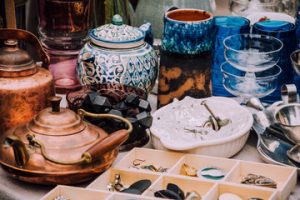Antiquities span the full timeline of human civilizations, from Paleolithic cave paintings to Egyptian mummies and Greek sculpture. These ancient objects are our cultural heritage and must be treated with care by trained conservators and restorers.

Reputable dealers guarantee the authenticity of antiquities they sell and conduct due diligence, a system of checks that includes checking an object against databases of known stolen or lost items. This is crucial in the fight against illicit trafficking of art. Visit https://www.gognasrl.it/antiquariato/acquistiamo-in-tutta-italia/stime-perizie-valutazioni-antiquariato-antichita-a-roma-lazio/ to learn more.
Authenticity is a key concern when collecting antiquities. While banning the trade would not solve the appearance of fakes or looted items, collectors should be aware that there are alternatives and practices that prioritize the preservation of our cultural heritage while satisfying individuals’ interest in ancient artifacts.
Antiquities are precious tangible links to our collective past and have a powerful appeal that transcends mere aesthetics and craftsmanship. However, they can be fragile and require special care. Ideally, an antiquity should be kept in a secure environment that is out of direct sunlight and away from chemical exposure. It is also recommended that any significant change in temperature or humidity should be avoided.
The global antiquities market is regulated by strict international conventions, national laws and ethical guidelines. These regulations prevent the sale of illegitimately excavated or illegally obtained archaeological materials from disappearing into private collections without proper documentation. The 1970 UNESCO Convention provides the fundamental framework, requiring that all transactions involve documentation of legal export from the country of origin. However, the definition of national patrimony varies widely across countries and some claim ownership of all archaeological materials found within their borders regardless of historical collection patterns or good faith acquisition.
Distinguished provenance, museum exhibition and scholarly recognition significantly enhance antiquities values by providing authentication support and market credibility that appeal to sophisticated collectors. The specialized nature of the antiquities market presents distinct valuation and legal complexity requiring expert analysis.
Specialized fine arts insurance and certified appraisals provide protection and value that are customized for antiquities’ unique characteristics. Authentication experts, conservators and academic advisors provide expert guidance on legal compliance, import/export restrictions, ownership rights and due diligence requirements that ensure safe and compliant collecting.
The global antiquities market is a complex ecosystem that intersects with centuries of culture, international law and ethical concerns. As such, there is a vast array of potential legal issues, ethical considerations and responsibilities to consider when acquiring or selling antiquities. It is vital to seek out a trusted advisor who can help navigate the various complexities of the market.
Due Diligence
Due diligence is a critical business process that ensures financial stability and legal compliance. It’s used in many different industries, including real estate and M&A (mergers and acquisitions), and it helps businesses validate information before making high-stakes decisions.
When it comes to antiquities, due diligence involves research into the object’s provenance. Provenance research reveals who owned the artifact at key points in its history, and it also helps prevent illicit trafficking of cultural property. Unfortunately, few antique buyers conduct thorough provenance research before purchasing items in the four-figure range and above. This is a serious risk to the broader field of collecting and could be exploited by criminals to smuggle antiquities into countries where they are illegally exported.
To perform proper due diligence, a collector should ask for copies of all documentation related to the object’s history. This should include bills of lading, invoices, customs entry forms, export permits, and other paperwork that tracks the object’s movements over time. It is also important to look into whether an object has been reported as stolen in the Art Loss Register and INTERPOL databases.
Due diligence in the art world is similar to that used in the real estate industry, and it’s essential to the safety of all parties involved. It allows potential buyers to investigate a home or other property before officially signing a contract, which can save them from ending up with a home they aren’t happy with for any number of reasons, including structural issues, flooding hazards, or noisy neighbors.
When storing antiquities, it’s important to make sure they are protected from moisture and sunlight. Also, storing them in acid-free boxes or paper enclosures is best for preserving the items. These containers help keep out oxygen, which can discolor or weaken certain ceramics over time.
In addition to performing due diligence, it’s important for museums to advocate for stricter laws and regulations around the buying and selling of antiquities. Museums can use their power and influence to push for laws that define “antiquities” as narrowly as possible, establish high thresholds for reporting requirements, and limit the impact of law enforcement’s new antiquities regulations on legitimate sales.
Provenance Research
The discipline of provenance research is a key element in the overall curatorial work of a museum. It is the detailed, interdisciplinary research that traces the ownership history of an object or artifact from its place of origin to its present location, and sometimes back again. In addition to revealing information about the authenticity and attribution of a work, it can also illuminate larger historical narratives concerning the art market and the interplay between individuals, institutions, and nations.
Provenance research is most often conducted using archival records—such as sales or purchase receipts, shipping documents, or inventory lists—but the objects themselves can also carry important clues, such as labels or stamps applied by previous owners to the reverse of a painting, the plinth of a sculpture, or the inside of a book cover. A thorough examination of the scholarly literature and specialized databases is also part of the process, as is careful review of auction catalogs. The Ryerson and Burnham Libraries at the Nelson-Atkins offer a variety of tools to support provenance research.
In recent years, provenance research has come to the forefront as museums have faced challenges over the return of antiquities that were illegally looted from their holdings in countries such as Syria and Greece. Additionally, the Washington Principles on Nazi-Confiscated Art and the Native American Graves Protection and Repatriation Act have added an ethical dimension to the field of provenance research.
Regardless of these issues, the broader context for provenance research is one of establishing lawfully held, scholarlyally valuable objects in a museum collection. This is particularly important for archaeological material and ancient art, where a full, contemporary ownership history may not be obtainable.
In keeping with museum ethics and AAM’s Nazi-Era Provenance Guidelines, the Museum is making a concerted effort to research the past ownership of paintings, decorative arts, sculptures, and works on paper in its collections that possibly passed through continental Europe between 1933 and 1945. The results of this research are publicly available on the museum’s Nazi-Era Provenance Internet Portal. Moreover, as an AAM member, the Museum will continue to prioritize researching Nazi-era provenance for European paintings, sculptures, and drawings it acquires or proposes to acquire.
Conservation and Restoration
The distinction between conservation, preservation and restoration is an important one when it comes to preserving the integrity of historical artifacts. Conservation is any action that maintains an object in its current state, minimizes change and slows or prevents further deterioration. The goal is to prolong the life of an object while ensuring that it remains accessible for present and future generations. Preventative conservation can be done through storage, stabilizing materials and chemical treatments that are typically reversible.
In contrast, restoration is a more invasive process that attempts to return an object to its original or assumed condition. This can be done through structural alterations, replacement or repair of materials, and painting using reversible paint products. In some cases, this can cause objects to lose their historic integrity.
When it comes to artifacts, it can be challenging to determine whether a particular piece should be conserved or restored. Cultural heritage sites in particular are constantly changing as the societies that inherit them transform and shift identities. The Parthenon has been a temple to both pagan and Christian gods, and the Hagia Sophia has served as both a cathedral and mosque over time. Choosing to preserve or restore an artifact to a specific historical period often carries significant political and cultural implications.
For example, if an iron car was left out in the weather for years, it might begin to show signs of corrosion or rust. A conservator could choose to apply a chemical treatment to stop the oxidation or even replace the entire piece of metal if it were damaged. This would be considered restoration and, if not carefully thought out, could erase the historic marker that this car once was a functional tool for a specific purpose.
The museum’s Curatorial team recently began compiling a list of artifacts in need of conservation. This included a model of the USS Arizona that was built aboard the ship before World War II. This model was showing signs of dry rot, so the team reached out to Tamar Maor at TM Art Conservation in Houston for help. After a thorough examination of the model, Maor recommended a combination of reversible and non-invasive conservation treatments that were successful in preserving its integrity.
